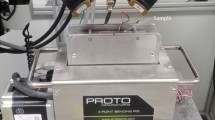Abstract
This paper describes the details of using Cure Reference Method (CRM) to determine the shrinkage that develops in concrete materials. The technique involves the replication of diffraction grating on the concrete specimen during curing. After demolded, the specimen is stored in a chamber where a specific drying condition is maintained for 6 days. Every day in this period, the specimen is removed from the chamber and a set of the consecutive moiré fringe patterns are recorded with the help of a specially-designed stage. An automated fringe analysis program is developed to obtain the full-field displacement and strain information. Shrinkage as a function of location, time, and drying conditions is measured. A numerical method is developed in order to obtain material properties from the complex geometry used in the tests. The test in different drying condition and the ring test are performed, and their results are compared with FEA to validate the constructed model.



















Similar content being viewed by others
References
ACI 209.1R-05 Report on Factors Affecting Shrinkage and Creep of Hardened Concrete, July 25, 2005
Bissonnette B, Pierre P, Pigeon M (1999) Influence of key parameters on drying shrinkage of cementitious materials. Cem Concr Res 29:1655–1622
Al-Saleh SA, Al-Zaid RZ (2006) Effects of drying conditions, admixtures and specimen size on shrinkage strains. Cem Concr Res 36:1985–1991
ASTM C157/C157M-06 Standard test method for length change of hardened hydraulic-cement mortar and concrete.
Mokarem DW, Weyers RE, Stephen Lane D (2005) Development of a shrinkage performance specifications and prediction model analysis for supplemental cementitious material concrete mixtures. Cem Concr Res 35:918–925
Kim J-K, Lee C-S (1998) Prediction of drying shrinkage in concrete. Cem Concr Res 28:985–994
Yang Y, Sato R, Kawai K (2005) Autogenous shrinkage of high strength concrete containing silica fume under drying at early ages. Cem Concr Res 35:449–456
Habel WR, Hofmann D, Hillemeier B (1997) Deformation measurements of mortars at early ages and of large concrete components on site by means of embedded fiber-optic microstrain sensors. Cem Concr Res 19:81–102
Yilmazturk F, Kulur S, Pekmezci BY (2003) Measurement of shrinkage in concrete samples using digital photogrammetric methods. The International Archives of the Photogrammtry, Remote Sensing and Spatial Information Sciences 34, Part XXX
Ifju PG, Masters JE, Jackson WC (1995) The use of moiré interferometry as an aid to standard test-method development for textile composite materials. Compos Sci Technol 53:155–163
Ifju PG, Kilday BC, Niu X, Liu S-C (1999) A novel method to measure residual stresses in laminated composites. J Compos Mater 33(16)
Ifju PG, Niu X, Kilday BC, Liu S-C, Ettinger SM (2000) Residual strain measurement in composites using the cure-reference method. J Exp Mechanics 40:22–30
Strickland NM, Yin W, Ifju PG (2007) Residual strain measurement analysis of woven composites using phase shifting. Proceedings of the 2007 SEM Conference on Experimental Mechanics, Springfield, MA, USA, June 4–6
Liu S-C (1999) Residual stress characterization for laminated composites. Ph.D. Dissertation, University of Florida, Gainesville, Florida
Speriatu ML (2005) Temperature dependent mechanical properties of composite materials and uncertainties in experimental measurement. Dissertation, Academic, UF, Mechanical and Aerospace Engineering
Post D, Han B, Ifju PG (1994) High sensitivity moiré: Experimental analysis for mechanics and materials. Springer-Verlag, New York
Huntley JM (1998) Automated fringe pattern analysis in experimental mechanics: a review. J Strain Anal 33(2):105–125
Ghiglia DC, Pritt MD (1998) Two-dimensional phase unwrapping: theory, algorithm, and software. Wiley, New York
Gonzalez RC, Woods RE, Eddins SL (2003) Digital image processing using MATLAB. Prentice Hall, New York
Sakata K (1983) A study on moisture diffusion in drying and drying shrinkage of concrete. Cem Concr Res 13(2):216–224
Ayano T, Wittmann FH (2002) Drying, moisture distribution, and shriankge of cement-based materials. Mat Struct 35:134–1140
Bazant ZP, Najjar LJ (1972) Nonlinear water diffusion in nonsaturated concrete. Mater Struct 5(25):3–20
Jang C, Han B (2009) Analytical solutions of gas transport problems in inorganic/organic hybrid structures for gas barrier applications. J Appl Physi 105:093532
Acknowledgments
The authors are grateful to Florida Department of Transportation (FDOT) for the financial support and to the reviewers for their valuable comments.
Author information
Authors and Affiliations
Corresponding author
Rights and permissions
About this article
Cite this article
Chen, T.C., Yin, W.Q. & Ifju, P.G. Shrinkage Measurement in Concrete Materials using Cure Reference Method. Exp Mech 50, 999–1012 (2010). https://doi.org/10.1007/s11340-009-9300-3
Received:
Accepted:
Published:
Issue Date:
DOI: https://doi.org/10.1007/s11340-009-9300-3




